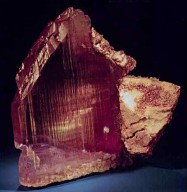
Scientific Information: Kunzite is a pink to purple variety of Spodumene. It is lithium aluminum silicate from the pyroxene group. It's chemistry is LiAlSi2O6. The hardness is rated at 6-1/2 to 7. The streak is white.
Environment: Kunzite is found only in granite pegmatities, where it generally occurs with tourmaline, albite, and lepidolite.
Occurrence: The Pala district in San Diego Co., California, produces gem-quality kunzite. It has also been found in Maine, Brazil and Madagascar.
Name: Kunzite is named after George F. Kunz, PhD. Dr. Kunz, a well known mineralogist, is the author of "The Curious Lore of Precious Stones".
Legend and Lore: Kunzite is a relatively new stone and not mentioned in ancient texts.
Magical Properties: This mineral is relatively unexplored for magical uses. Cunningham suggests that it is a centering/grounding stone and may also be useful for attracting love.
Healing: The position for this stone is the Crown Chakra. Because of it's high lithium content, it is recommended for psychological disorders involving severe/manic depression.
Personal Experience: My first exposure to Kunzite came about in one of those "it can't be coincidence" ways. I was preparing a medicine bag for a friend of a friend who is a diagnosed manic depressive. I had NO idea what would be a good stone to use for her, and had been concerned since nothing was "jumping out of the collection" to be "hers". I went shopping, and in the mall was a man selling stone/crystal jewelry. He had a dish of rough and semitumbled stones on the table. I walked right over and picked up a lovely purple-pink stone, and stood there talking to him about his display. Kind of suddenly, I blurted out "I want to buy THIS stone...How much?" He asked me what I wanted it for, and I actually TOLD him. I also said, I don't know what this is, but I know it is the right thing to use. He laughed, and explained to me what it was and GAVE it to me to use. As it turned out, the piece was granular, and I found a gem-quality piece to use in the medicine bag. I now use the granular piece all the time for treating sever depression and other related psychological disorders.
Notes: Kunzite will gradually fade with exposure to sunlight.
It has very high spiritual love vibration. Heart opener - it awakens the highest heart consciousness. It will connect one to their own infinite source of love. Aligns the crown and heart chakras. Symbolizes a pure expression of joy in thoughts and feelings. A good stone to be worn by star children or walk-ins to help them adjust to earth plane environments and energy.
Compiled by Fern Bouchard
It has high lithium content makes Kunzite beneficial to individuals with addicitve behavior. Strengthens cardiovascular system. Aids manic depression. Excellent balancer for physical/emotional/mental bodies. Powerful stone for opening/healing heart. Helps one surrender to Higher Self. Enhances self-esteem. Tolerance, acceptance. Soothing, calming. (4)
By Legion of Light
Bibliography
Kyanite strengthens throat chakra. Enhances creative expression, communication, truth, loyalty, reliability, serenity. Connection to causal plane. Facilitates astral/interdimensional travel. (4)
By Legion of Light
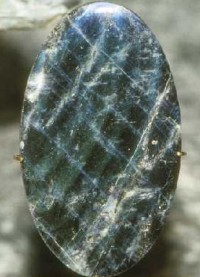
Scientific Information: Labradorite is from the plagioclase feldspar group, a mixture of sodium and calcium aluminum silicates. It is gray, green, bluish, and sometimes a play of various colors; vitreous; frequently pearly on cleavage. Chemical composition: (Na,Ca)AlSi3O8. The streak is white. It's hardness is 6. Labradorite is one of the lime-soda feldspars, along with bytownite and anorthite. Crystals are uncommon, but when found in fine grade, they are pale yellow.
Environment: The plagioclase feldspars are important rock-forming minerals and are found in many kinds of igneous and metamorphic rocks. Labradorite occurs with hornblende and augite in gabbro of plutonic rocks; also with hornblende in basalt of volcanic rocks.
Occurrence: Fine Labradorite showing beautiful colors comes from East Labrador. In addition, it has been found in the Adirondack Mountains of New York, in Essex and Lewis counties. Some has been found in Findland and a fine grade in Madagascar. Pale yellow crystals have been found in Utah, California, Oregon and Texas.
Gemstone Information: Only the finest Labradorite, showing distinct change of color (labrador-escence), is considered a gemstone. Greenish, bluish, yellowish, or reddish change of color may occur; blues and greens are most common, and the color change may be only in patches. There are some fine-grade, pale yellow crystals that can be faceted. However, most crystals found are "damaged" or flawed with cracks, rendering them uncuttable.
Name: Labradorite is named after the location in which it was first discovered, Labrador.
Magical Properties: This stone is not mentioned in Cunningham or Mella, or Fernie.
Healing: "Gem healers claim it elevates the wearer's consciousness and connection with the energies of the universe." (8)
Personal Experience: I have two small pieces of Labradorite. I use them at the Third-Eye Chakra because of their blue/bluish quot;sheen". I can't say that the results have been notable, since I've used them in conjunction with other stones. Sometimes, if I am going to participate in a "meditation circle" where I know I will be doing "readings", I will stick the larger piece in my pocket.
Notes: This stone is sometimes called "Spectrolite", in the non-crystalized form. (8) Labradorite is sometimes carved into ashtrays and various decorative objects. A translucent labradorite forms luscious black moonstones. (2)
Bibliography
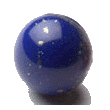
Scientific Information: Lazurite is a silicate of sodium calcium and aluminum, with some sulfur. It is a member of the sodalite group. It's chemistry is (Na,Ca)8(Al,Si)12O24(S,SO)2. The color ranges in shades of blue from violet blue and azure blue thru greenish-blue. Lazurite is distinguished from sodalite by its deeper color and fine grain. It is also softer and lighter in weight than lazulite. It is dull to greasy and the streak is pale blue. The hardness ranges between 5 and 5-1/2.
Environment: Crystals are rare. It is usually granular, compact, massive. It forms in association with pyrite, calcite, and diopside in hornfels of contact metamorphic rocks. The opaque, vivid blue, light blue, greenish-blue, or violet-blue stone, consisting largely of lazurite but with appreciable amounts of calcite, diopside, and pyrite, is a rock called [lapis lazuli.] The stone is usually veined or spotted. Its value depends largely upon excellence and uniformity of color and absence of pyrite, although some purchasers prefer lapis with pyrite.
Occurrence: Lazurite is a rare mineral in North America, but it does occur on Italian Mt. in the Sawatch Mts. of Colorado; on Ontario Peak in the San Gabriel Mts., Los Angeles Co., and in Cascade Canyon in the San Bernardino Mts., San Bernardino Co., California. The finest lapis lazuli has come from Badakshan in Afghanistan, and less valuable material has come from Russia and Chile.
Name: The name is from the Arabic [lazaward], "heaven," which was also applied to sky-blue lapis lazuli.
Legend and Lore: Lapis Lazuli was a favorite stone of the ancient Egyptians. In the past Lazurite has been burned and ground to form the pigment "ultramarine." It was consider an aid to childbirth, and has long been associated with altered states of consciousness and trance work. Lapis is sometimes designated as a birthstone for December, although turquoise is most common.
Magical Properties: To quote Cunningham: "This stone is used in rituals designed to attract spiritual love. Take an untumbled piece of lapis with a sharp edge. Empower the stone and a pink candle with your need for love. Then, using the lapis lazuli, carve a heart onto the candle. Place the stone near the candleholder and burn the candle while visualizing a love coming into your life." Actually, the most important magical aspect of lapis is it's ability to strengthen psychic awareness. Cunningham says "Despite its somewhat high price, lapis lazuli is one stone every stone magician should own and utilize."(2)
Healing: This stone is used at the Ajina, the Brow Chakra. It's related gland is the pituitary. The pituitary gland is also referred to as the "master gland" because it regulates all of the others. This location is also the center for the eyes, ears, nose and brain.
Personal Experience: I don't often use Lapis for physical healing, unless I feel that there is a "link" between what is manifested as disease, and some conflict of the "higher self". I have used it for brain disorders (tumors, inflammation, etc.) More often, I use it in layouts where the client is trying to achieve an altered state of consciousness.
It was used by ancient healers as an energy stone to strengthen the mind and prepare the body for spiritual awareness. Stimulates inner vision and enhances wisdom, insight, and good judgement in the practical world. Powerful thought amplifier. Opens the chakras, strengthens and balances, and induces psychic experience. It attracts spiritual love, cheers all moods and ills, and is useful in incest recovery. Helps us become more in touch with our essence and play a more active role in the control of our existence. Stimulates creativity, speech, and sincerity.
Not to be confused the Ruby in Celtic Mythology or with the Sapphire.
In Egypt, this is the stone for Royalty only. It gave wisdom and psychic experiences and guided the soul into the afterlife. It is thought to represent truth. It strengthens the mind and body through spiritual awareness. It is the stone of truth and also the stone of mystery.
It will aid in meditation and psychic development, it lifts depression and melancholy and brings success in love.
The color is inherently soothing.
It has been used for skin diseases and circulatory problems and against recurrent fevers.
Compiled by Lady Hathor - The Siver Circle - Toronto, Ont.
Strengthens skeletal system. Activates thyroid gland. Releases tension and anxiety. Energizes throat chakra. Augments strength, vitality, virility. Facilitates opening of chakras. Mental clarity, illumination. Enhances psychic abilities and communication with Higher Self and Spirit Guides. Creative expression. (5,6)
By Legion of Light
Bibliography
Scientific Information: Lepidolite a potassium, lithium, aluminum fluorsilicate mica. Its chemistry is complex: K(Li,Al)3(Si,Al)4O10(F,OH)2. It is pink, lilac, yellowish, grayish white or a combination of all of these. The streak is colorless. It is one of the softer stones, with a hardness of 2-1/2 to 3.
Environment: Lepidolite is confined to granite pegmatites, where it occurs either as fine-granular masses near the core of the pegmatite or as stubby or tabular crystals in cavities. It is commonly associated with microcline, quartz, and tourmaline.
Occurrence: Large fine masses of lepidolite have been mined at the Stewart Pegmatite at Pala, and superb sharp crystals have been obtained from the Little Three Pegmatite near Ramona, both in San Diego Co., California. It has also been mined in substantial amounts in several New England states and in the Black Hills of South Dakota.
Name: The name comes from the Greek [lepidos], meaning 'scale', in allusion to the scaly aggregates in which the mineral commonly occurs.
Legend and Lore: Lepidolite is a stone that could certainly be considered "new age" in the sense that it is just now coming into recognition by healers and magicians. There is no "past lore" on this stone, to the best of my knowledge. Part of this may be due to the fact, that it is native to the United States.
Magical Properties: "This stone soothes anger, hatred or any other negative emotion. To quiet the entire house, place lepidolite stones in a circle around a pink candle." (2)
Healing: Lepidolite is also know as the "Dream Stone". It will protect the individual from nightmares, especially those caused by stress or an upset in personal relationships. It can be used in the same types of circumstances as Kunzite, namely for manic depression or schizophrenia.
Personal Experience: This is one of the most soothing and relaxing stones I've ever held. It is a beauty to look at, and calms the mind enabling it to concentrate on the TRUE source of a problem...instead of running around in frantic circles accomplishing nothing. The more rubellite in the stone, the better it will help the heart and mind work together.
Notes: Lepidolite has been used as a source of lithium. The above description of the appearance of this stone may be deceiving, as I found Cunningham's to be, also. All of the specimens of this stone that I have seen so far have been grey to a pale lavender grey with "sparkles" of the lithium mica embedded in it. The heart-shaped cabochon that I have also has very distinctive crystals of rubellite (pink tourmaline) and veins of white running through it. I was originally looking for a MUCH brighter lavender stone. It is unusual, also, to find specimens that are cut and polished. Usually the stone is too "crumbly" to take a good polish. However, it is equally handsome in rough form.
Lepidolite aids muscles, strengthens heart, beneficially influences blood. High lithium content aids emotional/mental balance and stability. Aids sleep. Enhances expression of one's inner light and joy. (4)
By Legion of Light
Bibliography
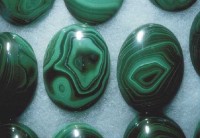
Scientific Information: Malachite is a basic copper carbonate. It's chemistry is Cu2CO3(OH)2. It ranges in color from emerald green thru grass green to shades of silky pale green. The streak is light green. It's hardness is 3-1/2 to 4. Crystals are rare. Most gem specimens display distinctive concentric colorbanding; (alternating dark green and light green bands.)
Environment: Malachite is a secondary copper mineral and develops in the zone of alteration in massive, lode, and disseminated hydrothermal replacement deposits. Associated minerals are azurite, limonite, and chalcopyrite.
Occurrence: The copper mines at Bisbee, Chochise Co., Arizona, are famous for their fine specimens of massive malachite and pseudomorphs of malachite after azurite. Mines at Morenci in Greenlee Co., and at Globe in Gila Co., Arizona, have yielded beautiful malachite specimens, of which some consist of alternating layers of green malachite and blue azurite. Fine malachite has also come from copper mines in California, Nevada, Utah, Pennsylvania, and Tennessee.
Name: The name is from the Greek [moloche], "mallow," an illusion to the mineral's leaf-green color. Malachite is used as an ore of copper and as a gemstone.
Legend and Lore: It is said that if malachite is worn, it will break into pieces to warn the wearer of danger.
Magical Properties: Used to direct power towards magical goals. Protective, especially towards children. According to Cunningham, "Small pieces of malachite placed in each corner of a business building or a small piece placed in the cash register draws customers. Worn during business meetings or trade shows, it increases your ability to obtain good deals and sales. It is the salesperson's stone." (2)
Healing: If the malachite is of the blue-green variety, it can be associated with the Sacral Center, or Splenic Chakra (Svadisthana). Here, it's energy branches to the left, to the spleen. (It is intended in this position for those who are celibate.) In addition, if it is grass-green, it can be used at the Lumbar/Solar Plexus Center. "When the malachite is placed at the solar plexus and a piece of green jade is placed at the heart center and a double-terminated quartz crystal is placed between them, people may remember events that have been blocked for years. They may cry or scream. As these buried emotions are brought to the surface and released, a great weight is lifted and they soon feel renewed." (3)
Personal Experience: I am very careful about using Malachite. It has been my experience that the emotions that it releases can be very powerful, to the point of overwhelming some people. On the other hand, if the individual is ready to deal with them (in a "growth" period) it may work out just fine. You could "balance" the emotional content with a pink stone (such as rose quartz) to cut down some on the intensity. A few years ago, I broke my arm. To do so, I damaged the muscles and nerves in my wrist. I was in a lot of pain, and was searching for what I could do to help the situation. During a journey, I saw malachite, so I found a malachite heart which I held in the palm of the broken arm while meditating. I got a lot of relief from it. Now, if the wrist acts up, I use the heart, taped over the wrist area when I go to bed at night. It seems to help quite a bit. I now recommend malachite for nerve/muscle damage with some success. (4)
Malachite acts as a purger and a mirror to the subconscious, reflecting into the conscious mind that which needs to be cleansed. It absorbs energy, so it is good to place over diseased or painful areas to draw out negative energy. It is important to cleanse these stones after every use but saltwater is too harsh. Serves best over the solar plexus to clear static or repressed emotions (use adventurine to soothe). Purifies the digestive system, balances blood sugar and bile levels. Salesperson's stone. A small piece in the cash register draws customers.
Compiled by Fern Bouchard
Malachite aids functions of pancreas and spleen. Reduces stress and tension. Aids tissue regeneration. Strengthens heart, circulatory system, pineal and pituitary glands. Aids sleep. Vitalizing for body/mind. Reveals subconscious blocks. Excellent balancer on all levels. (4,3)
By Legion of Light
Bibliography
Gold: Purifies and energizes the physical body, improves circulation, strengthens nervous system. Balances and develops heart chakra. Balances hemispheres of brain. Aids tissue regeneration. Attracts positive energy into aura. Amplifies thought forms. Aids personal illumination. Solar energy/male aspect. (2,4,7)

Silver: Enhances mental functions. Aids circulation. Strengthens blood, physically and etherically. Strengthens pineal and pituitary glands. Relieves stress. Relates to the moon, subconscious, female aspect. Emotional balance. Speech improvement. Excellent energy conductor.
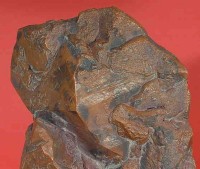
Copper: Influences flow of blood. Supplies strong energy to body/mind. Aids metabolism. Helps detoxify body. An aid for exhaustion and sexual imbalance. Aligns physical/emotional bodies. Raises self-esteem. Strong conductor of energy.
By Legion of Light

Meteorites help reveal past lives from other planets and galaxies. Enhances connection with extraterrestrial energies. Expands awareness. Similar to obsidian, but denser. (1)
By Legion of Light
Moldavite is a deep green silica-based tektite (meteorite) that fell to Earth about 15 million years ago. Aids alignment with Higher Self. Balancing and healing for physical body/mind. Aids in channeling extraterrestrial and inter-dimensional sources. (4,6)
By Legion of Light

Scientific Information: Moonstone is one variation of Orthoclase. It owes its beautiful silvery to bluish sheen ('adularescence' or 'schiller') to its composition of extremely thin plates of orthoclase and albite. The thinner these plates are, the bluer is the sheen. There are also moonstones consisting mainly of albite. These are less translucent, but they can occur in a variety of colors: grey, blue, green, brown, yellow and white. There are also moonstone cat's-eyes. The chemical composition is KAlSi3O8 and the hardness is 7. The streak is white.
Environment: The potash feldspars are important rock-forming minerals in plutonic, volcanic, and metamorphic rocks. Adularia and sanidine are found usually in volcanic rocks.
Occurrence: The main countries of origin are Ceylon, southern India (the district near Kangayam), Tanzia and Malagasy which, together with Burma, produces some of the finest stones with a deep blue schiller. White adularia crystals up to 2.5 cm (1") across have been found in gold-bearing quartz veins at Bodie, Mono Co., California, and in the silver mines of the Silver City district, Owhyee Co., Idaho.
Gemstone Information: Moonstone is always cut into cabochons, to display the cat's-eye, or schiller.
Name: Adularia (another name for Moonstone) comes from the locality in Switzerland, the Adula Mts.
Legend and Lore: This stone has always been revered because of its lunar attraction. It was believed that the shiller in the stone would follow the cycles of the moon. (Becoming greatest when the moon was full.) In addition, it has always been considered a "feminine, or Goddess" stone.
Magical Properties: Meditation with moonstone calls into consciousness the three-form moon phase goddesses, Diana/Selene/Hecate, the waxing, Full and waning Moon. These are woman as goddess in her ages and contradictions, Maiden/ Mother/Crone. Cunningham favors this stone for spells involving love. In addition he has a longish essay on using it for a "diet" stone.
Healing: Because of it's feminine nature, Moonstone has long been considered a "women's healing stone". It is used traditionally for healing/balancing of female organs and hormones.
Personal Experience: I use Moonstone at the Transpersonal Point, for connection to the Goddess and Universal Feminine Energy. This is the connection to dreams and dreaming, feminine "intuition", and "cycles". There are cycles of time, seasons, the moon, stars, etc. I also use/give this stone for those clients who are having difficulty being in tune with the feminine side of their nature. (Everyone has a masculine and a feminine side.)
Notes: In the past, this stone has also been called "Cylon Opal".
Moonstone bestows the gift of prophecy and second sight. Heightens psychic sensitivity and trance states. A psychic mirror (feminine) for the emotions. Brings happy love experiences. Accentuates the receptive (feminine) qualities of the personality. Renews or maintains a youthful appearance and attitude. Helps you lose weight - rub over problem areas. Helps balance women's cycles and is of considerable aid during the birthing process.
Compiled by Fern Bouchard
A stone of good fortune and a gift between lovers to insure enduring love as opposed to passionate but short term love.
It is not a stone for everyone as it will indicate mood and personality by changing color and transparency to reflect the feelings of the wearer. It also changes to suit the phase of the moon ,i.e. waxing grows brighter, full color, waning grows darker.
They aid in the accuracy of scrying and divination especially if held by the client.
It reunites lovers and loved ones who have parted in anger, protects those who travel on water, and clears the mind of confusion and aids in clear, concise decision making.
Compiled by Lady Hathor - The Silver Circle - Toronto, Ont.
Moonstone has healing affinity with stomach, spleen, pancreas, pituitary gland. Unlocks lymphatic system. Relieves anxiety and stress. Aids birthing process, helps female problems. Emotional balancer; helps lessen tendency to over-react emotionally. Flexibility in attitudes. Aligns emotions with higher self. (4)
By Legion of Light
Bibliography
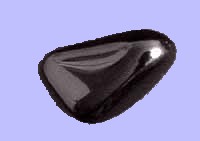
Scientific Information: Obsidian occurs as volcanic lava flows that are thick and of limited area. Its black, glassy, lustrous, and often flow-banded appearance makes it rather easy to distinguish from the other volcanic rocks with which it is commonly associated. This mineral forms when a silica-rich magma of granitic composition flows onto the earth's surface, where it solidifies before minerals can develop and crystallize. It is, therefore, an amorphous solid or glass rather than an aggregate of minerals. The hardness of Obsidian is between 6 and 7; it will scratch window glass. Although generally black, it is more or less smoky along translucent to transparent edges; other colors are gray, reddish brown, mahogany and dark green. When it has small white "flower" designs in it, it is called Snowflake Obsidian. It is also possible to find pieces with a sheen, or chatoyance. This is often called Rainbow Obsidian.
Environment: Obsidian is an environment for very few minerals. Lithophysae and spherulites may contain small but beautiful crystals of feldspar, tridymite, and cristobalite.
Occurrence: Some locations of Obsidian bodies are California (Inyo, Imperial, and Modoc Cos.), Oregon (Crater Lake), Wyoming (Yellowstone Park), and Mexico (near Pachuca.)
Name: The name is derived from the Latin name for the mineral, [obsio.]
Legend and Lore: Polished pieces of black Obsidian have been used for Scrying. Primitive peoples once valued obsidian highly, chipping and flaking it into knives, spearheads, and many other implements with razor-sharp edges resulting from the intersecting conchoidal fractures.
Magical Properties: Obsidian is a very protective stone. It is also associated with the inner mysteries of the Goddess, symbolizing entrance to the labyrinth, the womb or the subconscious self.
Healing: Because of its protective qualities, Obsidian is a good stone for those who are soft-hearted and gentle. It will help to guard them against abuse. This stone cleanses toxins from the liver, so it is also good for people who are exposed to environmental pollutants.
Personal Experience: This is the "balance" stone for Clear Quartz Crystals. We jokingly refer to it around here as a "dark sucker"...meaning it will absorb all sorts of negative things. It is also a grounding stone, and I use it at the Base Chakra (below the feet) at the beginning of a layout to keep my client "grounded". In India, the women wear obsidian toe rings for the same purpose. I use Black Obsidian in conjunction with Quartz. If I'm not using Clear Quartz, I use Snowflake Obsidian. I also have a piece of Rainbow Obsidian, but it is relatively new and I haven't finished "conversing" with it, so I have no advice as to how to use it...at the moment.
Obsidian is a protective stone. It helps prevent emotional draining by others and prevents the soft-hearted from being misused. A psychic mirror (masculine) for hidden emotions. Help you accept higher vibrations. Involved with survival bringing body and spirit together. Grounding.
Snowflake Obsidian: Sharpens the external and internal vision. Shows the contrast of life: black - symbolizes mastery over the physical plane, white - symbolizes the purity inherent in all of us. It will help you clear out all the cobwebs in the corners of your mind.
Compiled by Fern Bouchard
Obsidian beneficially influences stomach and intestines. Connects mind and emotions. Slightly masculine energy. Grounds spiritual-energy into physical plane. Absorbs and disperses negativity. Reduces stress. Helps clear subconscious blocks. brings an understanding of silence and "the void". Detatchment, but with wisdom and love. Powerful healer for those attuned to it. (1)
By Legion of Light
Bibliography
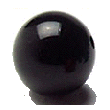
Onyx is a variety of chalcedony. Relieves stress. Balances male/female polarities. Strengthens bone marrow. Aids detatchment. Enhances emotional balance and self-control. Higher inspiration. Works with chakras and attitudes according to color of stone.
By Legion of Light
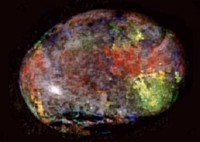
Scientific Information: Opal is hydrous silica, often with some iron and aluminum. Its chemistry is SiO2.nH2O; amount of water varies up to 10 percent. It ranges in color from White, yellow, red, pink, brown to gray, blue and even colorless. It is most easily recognized by its rich internal play of colors (opalescence). Its hardness ranges from 5-1/2 to 6-1/2. It is vitreous and pearly. The streak is white. It is not found in crystal form, rather is usually massive, botryoidal, reniform, stalactitic, and/or earthy.
Environment: Opal is a low-temperature mineral and usually develops in a wide variety of rocks as cavity and fracture fillings. It frequently develops as amygdules in basalt and rhyolite of volcanic rock and replaces the cells in wood and the shells of clams.
Occurrence: Common opal is widespread and can be readily obtained at many places, but localities for precious opal are rare and seem to localized in W United States and Mexico. Magnificent examples of opalized wood can be found in Idaho, Nevada, Oregon, Utah, and Washington, and lively green fluorescing opal (hyalite) occurs in seams in pegmatites in New England and North Carolina and in cavities in basalt near Klamath Falls, Oregon. Beautiful precious opal, as a replacement in wood, has been obtained in Virgin Valley, Humboldt Co., Nevada. Excellent fire and precious opal occur in lava flows in N Mexico. Nevada, Australia, and Honduras are sources for black opal; Australia and Czechoslovakia for white opal; Mexico and SW United States for fire opal.
Gemstone Information: Black, dark blue, dark green opal with dark gray body color and fine play of colors is called [black opal;] opal with white or light body color and fine play of color is called [white opal;] and transparent to translucent opal with body color ranging from orange-yellow to red and a play of colors is called [fire opal.] Play of colors depends upon interference of light and is not dependent upon body color. Black opal is the most highly prized, and fire opal is the most valued of the orange and red varieties. Most opal is fashioned into cabochons, but some fire opals are faceted.
Name: The word is from the Sanskrit [upala,] meaning "precious stone."
Legend and Lore: Opal is a birthstone for October.
"October's child is born for woe,
And life's vicissitudes must know;
But lay an Opal on her breast,
And hope will lull those foes to rest." (5)
Opals have traditionally been considered "lucky" stones...but only for those born in the month of October. It has been considered bad luck to wear them if you were born in any other month.
Magical Properties: Opal is considered to be able to confer the gift of invisibility on its wearer. To accomplish this, Cunningham says "The gem was wrapped in a fresh bay leaf and carried for this purpose." He also says, "Opals are also worn to bring out inner beauty. A beauty spell: Place a round mirror on the altar or behind it so that you can see your face within it while kneeling. Place two green candles on either side of the mirror. Light the candles. Empower an opal with your need for beauty -- while holding the stone, gaze into your reflection. With the scalpel of your visualization, mold and form your face (and your body) to the form you desire. Then, carry or wear the opal and dedicate yourself to improving your appearance." (2)
Healing: Opals contain all the colors of the other stones, thus, it could be used in place of any of them. (They are akin to quartz crystals, in this aspect.) Generally speaking, Opal is used more frequently for healing the spirit, rather than the physical body.
Personal Experience: Opals are probably my favorite stone. This may be partially due to the fact that they are my birthstone, and I have been surrounded by them all of my life. For me, they are protective and invigorating. I normally use them during Journeying, and when doing "readings" for other...anything where I am using altered states of consciousness. I find that they help me to understand the symbols of my visions in a way that makes them meaningful for others.
This stone carries immense quantities of energy, both positive and negative and is thus the stone of fortune and misfortune. It is also called the stone of the Gods since it carries all colors. It represents all four elements. It attracts to the wearer whatever is written on its self. It opens the visionary aspects of the mind and encourages and aids visions and psychic journeying. It also strengthens memory and revives and clears the mind. It is also used in prophecy and divination by placing over the third eye.
It offers protection from eye diseases ( often by being wrapped in a bay leaf and being placed on the eyelid) It is used to grant wishes and to add to magickal workings. Placed in the left hand it gives affirmation of purpose, in the right hand it will strengthen the work its self. Placed on the forehead, it gives direction to thoughts and gives direct linkage to Mercury.
It provided strong aid when offering help and guidance for others but may be quite negative when used selfishly for ones self. Opals are absorbtive, they pick up energy of every type around them. They do not water. When surrounded by positiveness and security, they are quite clean and they are quite clear and bright but when negativity comes along they become cloudy. They guard a persons honor. They were once considered to be the patron stone of thieves. Also they keep the hair from going grey and are useful against boils.
Compiled by Lady Hathor - The Silver Circle - Toronto, Ont.
Opal stimulates pineal and pituitary glands. aids eyesight. Emotional balanceer. Enhances intuition. the full spectrum of colors resonates with all chakras. Helps conscious connection with highest aspects of being. (4 others depending on color)
By Legion of Light
Bibliography